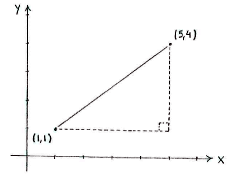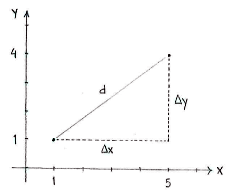Solution 4.1:4a
From Förberedande kurs i matematik 1
If we draw in the points in a coordinate system, we can see the line between the points as the hypotenuse in an imaginary right-angled triangle, where the opposite and adjacent are parallel with the x- and y-axes, respectively.
In this triangle, it is easy to measure the lengths of the opposite and the adjacent, which are simply the distances between the points in the x- and y-directions, respectively.
| ∆x = 5 - 1 = 4 and ∆y = 4 - 1 = 3 |
Using the Pythagorean theorem, we can then calculate the length of the hypotenuse, which is also the distance between the points:
| \displaystyle \begin{align}
d &= \sqrt{(\Delta x)^2 + (\Delta y)^2} = \sqrt{4^2+3^2}\\[5pt] &= \sqrt{16+9} = \sqrt{25} = 5\,\textrm{.} \end{align} |
Note: In general, the distance between two points \displaystyle (x,y) and \displaystyle (a,b) is given by the formula
| \displaystyle d = \sqrt{(x-a)^2 + (y-b)^2}\,\textrm{.} |


